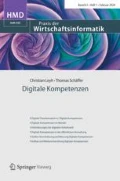Zusammenfassung
Immer mehr Unternehmen bieten ihren Kunden verschiedene Chatbots für unterschiedliche Geschäftsfälle an. Damit ein Kunde immer den passenden Chatbot für sein Anliegen findet, sollten die einzelne domänen-spezifischen, also auf bestimmte Geschäftsfelder spezialisierten Chatbots in korrekter Art und Weise miteinander interagieren können. Zudem sollte die Implementierung, Wartung sowie Koordination der verschiedenen Chatbots effizient bleiben. Ein Unternehmen muss folglich die geeigneten technischen Strukturen schaffen. Dieser Artikel stellt daher verschiedene Architekturmuster für Multi-Chatbot-Landschaften vor, diskutiert ihre Vor- und Nachteile und präsentiert eines davon, der Bot-Orchestrator, im Detail.
Abstract
More and more companies are building several domain-specific chatbots for their customers, which are specialized chatbots for certain domains. As a result, the company’s domain-specific chatbots must be able to interact with each other in the proper way for a positive customer experience. To keep the user experience consistent and the implementation, maintenance, and coordination of the specialized chatbots efficient, a company needs to create the appropriate technical landscape. This article therefore discusses different architecture patterns for multi-bot landscapes and presents one of them, the bot orchestrator, in detail.


Notes
Der Begriff Architekturmuster ist nicht zu verwechseln mit den weiter oben erwähnten Mustern, welche von Klassifikationsmodellen erkannt werden sollen. Architekturmuster sind Strategien oder analytische Werkzeuge, um wiederkehrende Probleme in der Informatik zu erfassen. Muster in Bezug auf Klassifikationsmodelle sind Klassen oder Typen, auf deren Erkennung ein Algorithmus oder ein Modell trainiert wird.
Unter Konfidenz oder Konfidenzwert verstehen die Autoren den Zahlenwert, mittels welchem die meisten Frameworks, Komponenten oder Cloud-Dienste für Intent Matching, wie etwa Rasa NLU (Rasa Technologies o.J.), Azure Cognitive Services (Microsoft Build 2020) oder Dialogflow (Google Cloud o.J.) die Gewissheit einer Klassifikation beziffern.
Literatur
Alexander C, Ishikawa S, Silverstein M (1977) A pattern language. Towns, buildings, constructions. Oxford University Press, New York
Besik L, Misra S (2020) New dialogflow mega agent for contact center AI increases intents by 10 times to 20,000. https://cloud.google.com/blog/products/ai-machine-learning/new-dialogflow-mega-agent-contact-center-ai-increases-intents-10-times-20000. Zugegriffen: 31. Mai 2020 (Erstellt: 19.02.2020)
Candello H, Pinhanez C (2018) Recovering from dialogue failures using multiple agents in wealth management advice. In: Moore RJ, Szymanski MH, Arar R, Ren GJ (Hrsg) Studies in conversational UX design. Springer, Cham, S 139–157
Celikyilmaz A, Deng L, Hakkani-Tür D (2018) Deep learning in spoken and text-based dialog systems. In: Deng L, Liu Y (Hrsg) Deep learning in natural language processing. Springer Nature, Singapore, S 49–78
Daigneau R (2012) Service design patterns. Fundamental design solutions for SOAP/WSDL and RESTful web services. The Addison-Wesley Signature Series. Addison-Wesley
Erl T (2009) SOA design patterns. Prentice Hall, Upper Saddle River
Fowler M (2002) Patterns of enterprise application architecture. The Addison-Wesley Signature Series. Addison-Wesley
Gamma E, Helm R, Johnson R, Vlissides J (1994) Design patterns. Elements of reusable object-oriented software. Addison-Wesley Professional Computing Series. Addison-Wesley
Gnewuch U, Adam MTP, Morana S, Maedche A (2018) “The chatbot is typing…”—the role of typing indicators in human-chatbot interaction. In: Proceedings of the 17th Annual Pre-ICIS Workshop on HCI Research in MIS San Francisco, CA, USA
Google Cloud (o.J.) DetectIntentResponse. https://cloud.google.com/dialogflow/docs/reference/rest/v2beta1/DetectIntentResponse. Zugegriffen: 22. Sept. 2020
Hansen LK, Salamon P (1990) Neural network ensembles. IEEE Trans Pattern Anal Machine Intell 12(10):993–1001
Hohpe G, Woolf B (2004) Enterprise integration patterns. Designing, building, and deploying messaging solutions. The Addison-Wesley Signature Series. Addison-Wesley
IBM (2020) Ergebnisrelevanz mit Training verbessern. https://cloud.ibm.com/docs/discovery-data?topic=discovery-data-train#confidence. Zugegriffen: 22. Sept. 2020
Jurafsky D, Martin JH (2019) Speech and language processing. 3rd ed. draft. https://web.stanford.edu/~jurafsky/slp3/ed3book.pdf. Zugegriffen: 15. Juni 2019 (Erstellt: 16.10.2019)
Kaskina A (2018) A fuzzy-based user privacy framework and recommender system. Dissertation. Universität Freiburg (Schweiz), UniPrint. http://doc.rero.ch/record/323492
Kore.ai (o.J.) Universal bots. https://developer.kore.ai/docs/bots/advanced-topics/universal-bot/universal-bots/. Zugegriffen: 31. Mai 2020
Kuncheva L (2014) Combining pattern classifiers. Methods and algorithms. Wiley, Hoboken
Lavendelis E, Grundspenkis J (2008) Open Holonic multi-agent architecture for intelligent tutoring system development. In: IADIS Multi Conference on Computer Science and Information Systems Amsterdam, The Netherlands
Luger E, Sellen A (2016) “Like having a really bad PA”: the gulf between user expectation and experience of conversational agents. In: Proceedings of the 2016 CHI Conference on Human Factors in Computing Systems, S 5286–5297
Microsoft Build (2020) The confidence score of an answer. https://docs.microsoft.com/en-us/azure/cognitive-services/qnamaker/concepts/confidence-score. Zugegriffen: 31. Mai 2020 (Erstellt: 27.01.2020)
Rasa Technologies (o.J.) Components. https://rasa.com/docs/rasa/nlu/components/#intent-classifiers. Zugegriffen: 31. Mai 2020
Rokach (2009) Taxonomy for characterizing ensemble methods in classification tasks: a review and annotated bibliography. Comput Stat Data Anal 53:4046–4072
Rokach L (2010) Ensemble-based classifiers. Artif Intell Rev 33:1–39
Serban IV, Sankar C, Germain M, Zhang S, Lin Z, Subramanian S, Kim T, Pieper M, Chandar S, Ke NR, Rajeshwar S, de Brebisson A, Sotelo JMR, Suhubdy D, Michalski V, Nguyen A, Pineau J, Bengio Y (2017) A deep reinforcement learning chatbot. arXiv preprint arXiv:1709.02349
Steinmetz R, Wehrle K (2005) What is this peer-to-peer about? In: Steinmetz R, Wehrle K (Hrsg) Peer-to-peer systems and applications. Lecture notes in computer science. Springer, Berlin, Heidelberg, S 9–16
Stucki T, D’Onofrio S, Portmann E (2018) Chatbot – Der digitale Helfer im Unternehmen: Praxisbeispiele der Schweizerischen Post. HMD 55(4):725–747
Stucki T, D’Onofrio S, Portmann E (2020) Chatbots gestalten mit Praxisbeispielen der Schweizerischen Post. HMD Best Paper Award 2018. Essentials. Springer Vieweg, Wiesbaden
Subramaniam S, Aggarwal P, Dasgupta GB, Paradkar A (2018) COBOTS—A cognitive multi-bot conversational framework for technical support. AAMAS, Stockholm
Zhuo Z (2012) Ensemble methods. Foundations and algorithms. CRC
Zumstein D, Hundertmark S (2017) Chatbots—an interactive technology for personalized communication, transactions and services. IADIS Int J 15(1):96–109
Danksagung
Die Autoren dieses Kapitels danken Samir Abdou, Nikolay Borissov, Lukas Feuz, Gianni Furger, Caroline Hertel, Linus Hüsler (Apptiva AG), Katharina Klobassa, Alla Povorozniuk, Mike Fernando Röthlisberger, Andreas Quandt, Martin Rüegsegger, Stefan Schärmeli, Bernhard Spörri, Markus Tanner (Apptiva AG), Ursula d’Onofrio, Raphael Tanner und Gregor Wägli für ihre wertvollen Inputs zum Artikel und für ihre Bemühungen in der Umsetzung des Orchestratormusters bei der Schweizerischen Post. Ohne sie hätte dieser Artikel in dieser Form nicht geschrieben werden können. Vielen Dank!
Author information
Authors and Affiliations
Corresponding author
Rights and permissions
About this article
Cite this article
Stucki, T., D’Onofrio, S. Architekturmuster für Multi-Chatbot-Landschaften: Bot-Orchestrator und Alternativen. HMD 57, 1187–1205 (2020). https://doi.org/10.1365/s40702-020-00668-x
Received:
Revised:
Accepted:
Published:
Issue Date:
DOI: https://doi.org/10.1365/s40702-020-00668-x

